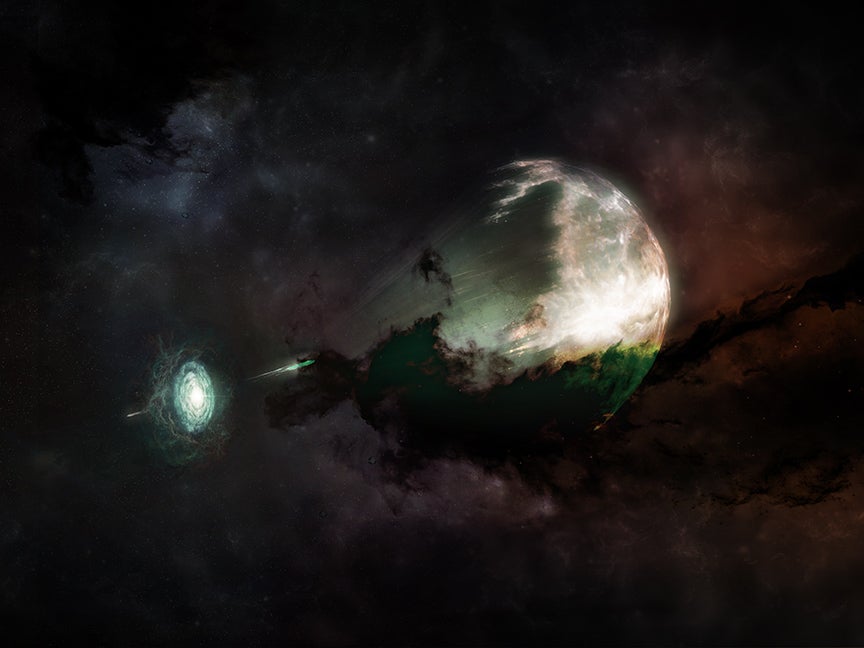Mysterious energy burst seen in millimeter wavelength radio astronomy for first time
Radio astronomers have captured the unique after glow of a massive explosive event in the distant universe

Your support helps us to tell the story
From reproductive rights to climate change to Big Tech, The Independent is on the ground when the story is developing. Whether it's investigating the financials of Elon Musk's pro-Trump PAC or producing our latest documentary, 'The A Word', which shines a light on the American women fighting for reproductive rights, we know how important it is to parse out the facts from the messaging.
At such a critical moment in US history, we need reporters on the ground. Your donation allows us to keep sending journalists to speak to both sides of the story.
The Independent is trusted by Americans across the entire political spectrum. And unlike many other quality news outlets, we choose not to lock Americans out of our reporting and analysis with paywalls. We believe quality journalism should be available to everyone, paid for by those who can afford it.
Your support makes all the difference.One of the most powerful flashes in the sky, the result of a star and a neutron star colliding, has been observed by millimeter wavelength radio astronomy for the first time, offering an unprecedented view of one of the most violent events in the Cosmos.
A research team led by Northwestern University in Illinois, and Radboud University in the Netherlands, used the Atacama Large Millimeter/submillimeter Array, or ALMA radio telescope in Chile to capture the afterglow of GRB 211106A, a short gamma ray burst (GRB) determined to originate in a galaxy 20 billion light years away.
“This short gamma ray burst was the first time we tried to observe such an event with ALMA,” Northwestern professor of physics and astronomy Wen-fai Fong said in a statement. “Afterglows for short bursts are very difficult to come by, so it was spectacular to catch this event shining so brightly.
Dr Fong is one of many authors on a study about the observation that will be published in an upcoming issue of Astrophysical Journal Letters, and is available online now on the academic preprint archive arxiv.org.
GRBs are powerful bursts of gamma radiation that occur when massive stars collapse into black holes, or dense neutron stars in a binary system merge with their companion stars to form a black hole, an intense cataclysmic event believed to forge most of the heavier elements in the universe such as gold and plutonium.
“These mergers occur because of gravitational wave radiation that removes energy from the orbit of the binary stars, causing the stars to spiral in toward each other,” Radboud University astronomer and lead author of the paper Tanmoy Laskar said in a statement. “The resulting explosion is accompanied by jets moving at close to the speed of light. When one of these jets is pointed at Earth, we observe a short pulse of gamma-ray radiation or a short-duration GRB.”
Short GRBs may only last a fraction of a second, but their afterglow may persist in longer, less energetic wavelengths of light for minutes or even days.
Such was the case with GRB 211106A, the afterglow of which was first detected in X-ray light by NASA’s Neil Gehrels Swift Observatory, then found in infrared light by the Hubble Space Telescope, and most recently in millimeter radio light by ALMA. It was only with the addition of the ALMA observation that the GRB was pinpointed in a distant galaxy.
“The Hubble observations revealed an unchanging field of galaxies,” Dr Laskar said in a statement. “ALMA’s unparalleled sensitivity allowed us to pinpoint the location of the GRB in that field with more precision, and it turned out to be in another faint galaxy, which is further away. That, in turn, means that this short-duration gamma-ray burst is even more powerful than we first thought, making it one of the most luminous and energetic on record.”
The Millimeter wavelength also provided scientists with a clearer picture of the structure and density of the environment around the GRB, according to Dr Fong, and even allowed researchers to measure the apparent width of the jet that triggered the burst at just more than 15 degrees, one of the widest ever measured.
The study highlights the value of observing complex phenomena in multiple wavelengths using the most sophisticated tools available, which now includes the newly operational James Webb Space Telescope.
“In the future, we could also use JWST to capture infrared afterglows and study their chemical composition,” Dr Laskar said in a statement. “I am excited about these upcoming discoveries in our field.”
Join our commenting forum
Join thought-provoking conversations, follow other Independent readers and see their replies
Comments